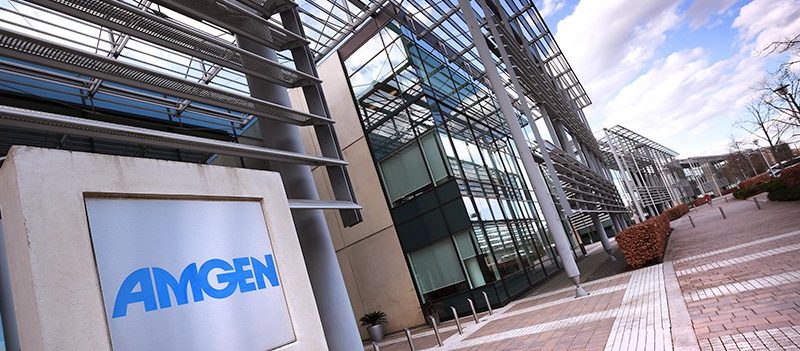Amgen already broke into the “undruggable” market with the approval of Lumakras, its KRAS inhibitor to treat non-small cell lung cancer, but that was just the tip of the iceberg for a pipeline strategy aimed at pursuing targets that were previously considered out-of-reach.
The California pharma’s early-stage pipeline is loaded with “multi-specific” drugs, which make up about 60% of the company’s hopefuls. Amgen is building on its experience developing bi-specific T cell engagers, or BiTEs, which include the approved cancer drug Blincyto.
The multi-specifics got a shout-out from Executive VP of R&D David Reese on Amgen’s third quarter earnings call earlier this week, even though the candidates are mostly in the earliest stages of development.
Ray Deshaies, Ph.D., Amgen’s SVP of global research said the pharmaceutical industry is at the very beginning of the so-called fourth wave of drug development. The first wave began with aspirin, when compounds were developed with a known chemical structure but unknown mechanism of action in the body. In the second wave, which began in the 1970s, rational drug design emerged with specific compounds going after known molecular targets that play a role in disease. The third wave in the 1980s was the biotechnology revolution when recombinant DNA technology was harnessed to create cells to produce protein-based medicines.

with chalk art at the American Society of Clinical
Oncology conference in 2019. (Amgen)
The fourth wave, happening now, is all about the multi-specific. So what is this new wave and why is Amgen staking the bulk of their pipeline on this rapidly advancing field?
Multi-specifics form connections between two or more proteins, kind of “molecular matchmakers,” as Amgen calls them. These drugs use the body’s own natural defenses to tackle targets that cause disease, instead of directly engaging with the target as conventional drugs have done. This process is called induced proximity and it’s the backbone of familiar drug types like antibody-drug conjugates.
The first approved multi-specific drug was Bristol Myers Squibb’s Revlimid, the blockbuster multiple myeloma treatment. But when it was approved, the exact mechanism of action was unknown, Deshaies said in an interview. It was only later that scientists figured out the drug was a multi-specific.
Now there’s a better understanding of multi-specifics, and Amgen has been making aggressive moves to bulk up its pipeline. That included its $2.5 billion acquisition of Teneobio in July, as well as the DNA-encoding libraries of Nuevolution in 2019.
Tenebio solved a number of problems for Amgen, bringing a host of multi-specific and bi-specific candidates into the pipeline. The biotech had developed a way to make very small antibodies that can bind to antigens. This was key to helping Amgen develop therapies that could bind to multiple targets while remaining small enough to fit into molecules that could be delivered to patients.
“It’s like if you’re playing baseball and your baseball goes into a thick hedge and it’s you and your small child, well who are you going to send into that big hedge to get that baseball? You’re going to send the small child,” Deshaies said. “It’s just easier for them to go between the branches to get the baseball because they’re physically smaller…. Well, it could be the same way with getting molecules into a tumor, to the tumor cell surface. Having a small molecule or a smaller molecule is potentially advantageous because it can wriggle between the branches, if you will, to get in there.”
Another advantage Teneobio brought is binding technology that can reduce the risk of the dangerous immune reaction cytokine release syndrome, which can limit dosing. This is something Amgen knows a bit about, having halted a trial of its FLT3 BiTE therapy AMG 427 due to cytokine release syndrome in some participants. Finally, one of Teneo’s bigger molecules paired perfectly with Amgen’s BiTE molecules to improve stability and manufacturing.
A large chunk of Amgen’s multi-specific pipeline focuses on cancer, but Deshaies says these medicines can work in other diseases, too. Roche’s Genentech has a bispecific antibody called Hemlibra approved for treating hemophilia A. Amgen is also exploring the use of multi-specifics in solid tumors, which have long stymied researchers.
Deshaies highlighted AMG-160, a BiTE in phase 1 development for prostate cancer and non-small cell lung cancer, which has already shown some promising early human data. That therapy is now known as acapatamab. He also flagged AMG-757, or tarlatamab, another phase 1 asset in small-cell lung cancer that has shown promise in the difficult third-line setting, where no treatment options currently exist. That therapy is also under development for a type of prostate cancer.
Amgen has three BiTEs in development for acute myeloid leukemia as well.
Deshaies knows that every single multi-specific is unlikely to make it onto the market, and there will be trimming along the way as the data rolls in. “It’s like asking people to pick which child do they like the best. We love all our children equally. And we try to give them all an opportunity to succeed, but, you know, some are likely to just succeed more than others,” he said.
The culling has already started, as Amgen has found a few candidates falter after data readouts. In addition to stopping the trial of AMG 427 in August, Amgen paused clinical trials of BiTE molecules against BCMA, CD33 and EGFR variant III in February.
Amgen isn’t alone in exploring multi-specifics and the new fourth wave of drug development, Deshaies said.
“What you’re seeing approved, that’s really a small fraction of what’s really being worked on at Amgen and elsewhere in the industry where there’s a huge bolus of programs that are below the waterline,” Deshaies said. “This is really starting to take off now and I expect in the coming decade we’re going to see a lot of these multi-specifics coming on board.”

